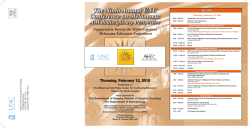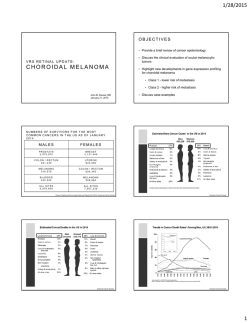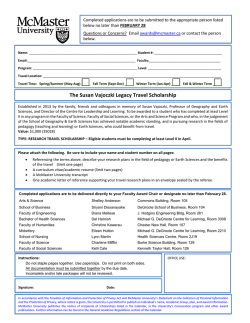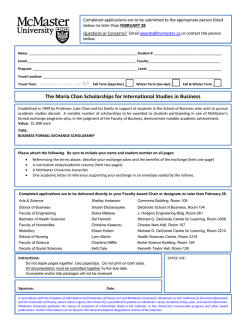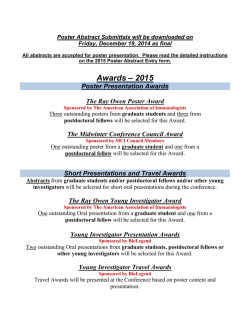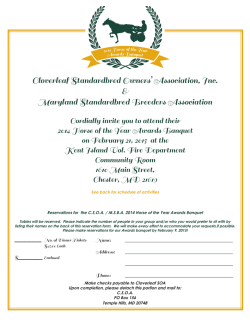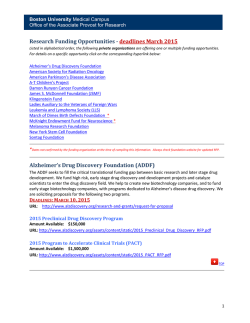
Melanoma Research Foundation Request for Proposals (RFP) 2015
Melanoma Research Foundation Request for Proposals (RFP) 2015 RESEARCH OVERVIEW: The Melanoma Research Foundation (MRF) is committed to advancing research across the spectrum of melanoma – from prevention through diagnosis, staging and treatment. The MRF proactively partners with the NCI, Congress, the Department of Defense and other foundations to develop and collaborate on a broad agenda for melanoma research that takes full advantage of all opportunities, while also sharing challenges. Since 1998, the MRF has funded over 90 innovative, high impact, basic, translational and clinical projects. In 2011, the MRF opened awards to medical students and accelerated targeted research into ocular melanoma through the CURE OM initiative. In 2014, the MRF awarded $2.3 million dollars in new melanoma research with plans to increase that funding in 2015. Please visit www.melanoma.org for additional information on the MRF and to learn more about previously funded research. All questions or concerns regarding the MRF’s Research Grant Program can be directed to the Program Director at [email protected] or by calling 800-673-1290. TYPES OF AWARDS OFFERED IN 2015: Medical Student Awards The Medical Student Awards provide funding of up to $3,000 for one year to medical students at accredited U.S. medical schools or institutions. These awards provide opportunities and funding for medical students to engage in short clinical or laboratory-based research projects focused on better understanding the biology and treatment of melanoma. The grant application process is through a separate award mechanism; additional details are available here. Career Development Awards (CDA) The CDAs provide funding of up to $50,000 per year for two years to junior investigators. Researchers who are beginning a research career focused on melanoma and have not yet established strong federal funding for their research are eligible. The use of relevant genetic models and human derived tumor samples is highly encouraged. Established Investigator Awards (EIA) The EIAs provide funding of up to $100,000 per year for two years to established melanoma researchers, or senior researchers working in closely related fields who wish to move into melanoma research. The use of relevant genetic models and human derived tumor samples is highly encouraged. Team Awards Team Awards provide funding of up to $250,000 per year for two years. Teams should consist of a PI and at least one co-PI, possibly from different institutions. Teams consisting of both basic scientists and clinicians to address an unmet clinical need are encouraged, as is the inclusion of a junior scientist. The use of relevant genetic models and human derived tumor samples is required. Use of clinically annotated samples, samples from clinical trials and trials conducted within the MRF Breakthrough Consortium (MRFBC) are particularly welcomed, but not required. All Team Awards must address one of the Specific Topic Proposals (STPs) identified below. Team applications should demonstrate how the proposal will answer the selected unmet need topic. Team applications need to establish the relative contribution of each member of the team for the proposed studies. A previous record of collaboration for the proposed team is advantageous. A minimum of two Team Awards are expected to be funded in 2015. SPECIFIC TOPIC PROPOSALS (STPs): The identification of scientific topics that address unmet clinical needs in melanoma research were identified through a series of meetings of multidisciplinary experts from the MRF’s Scientific Advisory Committee and Breakthrough Consortium Steering Committee. The following categories are the identified unmet needs in melanoma research selected as STPs for 2015 (please use links for additional details): Prevention: Development of models and biomarkers Identifying mechanisms and respective therapeutic strategies in less common molecular subsets of melanoma Metastases: Dormancy and metastatic progression CNS Metastases: Development of markers of risk and rational therapeutic approaches Response to treatment: Mechanisms and respective biomarkers for predicting response and for monitoring therapeutic response Resistance: Intrinsic/Innate/Primary resistance to immunotherapies in melanoma Applicants must clearly indicate which of the categories – if any – is being addressed in their application. In all cases, the scientific merit is the most important factor underlying the selection for funding. ELIGIBILITY & REQUIREMENTS: General (for all grant types) Applicants must hold a PhD or MD degree or equivalent An applicant may be the PI or co-PI on only one application, of any type Proposed research must be conducted in a non-profit research organization, a medical institution or an educational institution located in the United States Proposed research must comply with all applicable National Institutes of Health (NIH) animal and human welfare guidelines Applicants must show evidence of strong departmental or institutional support and commitment PIs and co-PIs may not have an active research award with the MRF Applicants are encouraged to discuss any eligibility questions with the MRF prior to submitting an application Career Development Awards (CDAs) Applicants who are postdoctoral fellows must have less than 5 years of postdoctoral experience and must not have previously received any major grant support (e.g. from ACS, NIH, NCI or DoD) Applicants who are not postdoctoral fellows may have a title of Research Associate or Assistant Professor, or equivalent Proposed research is highly encouraged, but not required, to use relevant genetic models and, as applicable, human melanoma tumor samples Applicants may, but are not required to, submit applications focused on one of the STP unmet needs Established Investigator Awards (EIAs) Applicants must have a title equivalent to Associate Professor or higher Proposed research is highly encouraged, but not required, to use relevant genetic models and, as applicable, human melanoma tumor samples Applicants may, but are not required to, submit applications focused on one of the STP unmet needs Team Awards PI must have a title equivalent to Associate Professor or higher PI is encouraged, although not required, to include a junior faculty member as part of the team PI is encouraged to establish teams consisting of basic scientists and clinicians Teams are expected to consist of a PI and at least one co-PI, possibly from different institutions PI and co-PI(s) may not serve as a PI or co-PI on another application, of any type International scientists may be eligible to participate in a Team Award as a co-PI or team member, but not as a PI. Prior to submission, the interested PI should inquire for eligibility and obtain specific approval from the Program Director. Team applications must use relevant genetic models and, as applicable, human melanoma tumor samples Team applications must focus on one of the STP unmet needs REVIEW PROCESS: The MRF’s Research Grant Program emphasizes basic, translational and clinical research projects that explore innovative approaches to understanding critical problems pertaining to prevention, diagnosis, staging and treatment of melanoma. All proposals will undergo rigorous peer review, where reviewers are selected based on their expertise in diverse areas of basic, translational and clinical melanoma research. Reviewers include members of the MRF’s Scientific Advisory Committee (SAC) and the Breakthrough Consortium (MRFBC) as well as members of the general international scientific and clinical melanoma community who are not in conflict with the application. Proposals receiving discrepant scores are subjected to interim review by a panel selected from the initial review group. Applications with the highest scores (including those that received a high score in the interim review) are then assessed by a panel of representatives from the initial review group. The top ranked grants are recommended for funding by the MRF’s Board of Directors. The number of grants selected for funding is determined by the MRF Board of Directors, based on available funds. AWARD ADMINISTRATION AND REPORTING: Award decisions will be made on or around August 25, 2015. Upon acceptance of the award, the PI and the Institution will be required to sign an award letter accepting all of the MRF’s terms and conditions. Awards will cover research conducted over a two-year period. Funds are distributed twice each year, on September 30 and March 31, for a total of four payments. A no-cost extension of one year may be permitted with sufficient justification from the PI and approval from the Program Director. Requests for a no-cost extension must be made within 30 days of the award period expiration. Interim financial and scientific progress reports are to be submitted to the MRF no later than 30 days prior to the end of the grant’s first year. Final financial and scientific reports, detailing all activities during the award period, are to be submitted to the MRF within 60 days of the end of the award period (even if a no-cost extension is requested). Acknowledgment of support from the MRF must accompany any published report using data or findings from research conducted under an award from the MRF STEP-BY-STEP APPLICATION INSTRUCTIONS: The MRF will accept applications from December 1 - March 1, 2015 for the 2015 award cycle. The deadline is March 1, 2015 at 5pm EST. All submissions, notifications and critiques will be completed entirely online through ProposalCENTRAL (https://proposalcentral.altum.com/). Please read the instructions carefully prior to beginning the online grant submission process. NOTE: Applications that represent resubmission of previously proposed studies, in whole or in part, may be submitted for consideration only twice. A letter referencing the project title, a summary of changes to the application from the previous submission, and responses to reviewers’ criticisms must be uploaded as an attachment during Step 11: Upload Attachments. Step 1: Title Page The project title should not exceed the space provided (75 characters, including spaces). Choose the grant program to which you are applying: Career Development Award (CDA) – up to $100,000 over a two year period o If applicable, please select the STP category in which you are applying Established Investigator Award (EIA) – up to $200,000 over a two year period o If applicable, please select the STP category in which you are applying Team Award – up to $500,000 over a two year period o Please select the STP category(ies) in which you are applying The research period for all awards is a two- year period beginning October 1, 2015 and ending September 30, 2017. Funds are distributed twice each year, on September 30 and March 31. Please specify if this is a new application or a resubmission. Step 2: Enable Other Users to Access This Proposal You have the option to allow other individuals access to your application. You can choose from three different levels of permission. Step 3: Applicant/PI Profile information is pre-loaded in this section. You may update your profile information here as well. Step 4: Institution and Contacts Institution information and contact information can be updated and/or changed here. Step 5: Key Personnel Key personnel, other than the applicant, who will provide support to the project, will be listed here. If this is a Career Development Award application, the PI should also list their mentor in this section. The CV/Biosketch of the mentor and/or key personnel will be required in Step 11: Upload Attachments. If this is a Team Award, at least one co-PI – possibly from a different institution – be. Step 6: Abstracts Scientific Abstract In the space provided, include a summary of the proposal that gives a brief description of the objectives, rationale, methods and expected results. The total length of the summary may not exceed 3,000 characters (including spaces) and should be written in scientific terms. Keywords: Please select up to six appropriate keywords (from the list provided) that characterize the proposed research project. Lay Abstract In the space provided, include a brief (<3,000 characters, including spaces) summary of the proposal. The lay level abstract needs to be written so that the everyday person can understand the significance, impact and innovation of the proposed research. Keywords: Please select up to six appropriate keywords (from the list provided) that characterize the proposed research project. If the project is awarded, portions of the abstracts may be used in the MRF’s various publications, press releases, fundraisers and educational events. Step 7: Budget Period Detail Awards will be made for a two-year period. Please fill out the budget information for both years. Only direct costs are allowed. Indirect institutional costs are not allowed. Career Development Awards (CDA) Personnel Costs All personnel may be named in this section. The salary and fringe benefits included in the budget is calculated based on total of salary and fringe benefits multiplied by the % effort. Salaries and fringe benefits may be included. The MRF will consider covering up to 50% of the salary for a CDA recipient. Non-Personnel Costs All budgeted expenses such as consumable supplies, animal costs, service fees and consultant fees must be itemized. Requests for major equipment will be closely scrutinized and should be carefully justified, and should not exceed 15% of the total (two year) budget. Indirect institutional costs are not allowed. Allowable travel expenses are capped at $2,000 per project year. Cost of living adjustments are not allowed. Career Development Awards will not exceed $50,000 per year. Established Investigator Awards (EIA) Personnel Costs All personnel may be named in this section. The salary and fringe benefits included in the budget is calculated based on total of salary and fringe benefits multiplied by the % effort. The MRF will consider up to 30% of the salary of the EIA recipient and up to 100% of the salary for a postdoctoral fellow or graduate student; if salary support for more than one (maximum 2) of these researchers is requested, the combined % cannot exceed 100. Non-Personnel Costs All budgeted expenses such as consumable supplies, animal costs, service fees and consultant fees must be itemized. Requests for major equipment will be closely scrutinized and should be carefully justified, and should not exceed 15% of the total (two year) budget. Indirect institutional costs are not allowed. Allowable travel expenses are capped at $2,000 per project year. Cost of living adjustments are not allowed. Established Investigator Awards will not exceed $100,000 per year. Team Awards Personnel Costs All personnel may be named in this section. The salary and fringe benefits included in the budget is calculated based on total of salary and fringe benefits multiplied by the % effort. The MRF will consider up to 30% of the salary for the PI and up to 20% for the salary of the co-PIs of a team award. Salary distribution of supporting personnel is up to the discretion of the PI. Non-Personnel Costs All budgeted expenses such as consumable supplies, animal costs, service fees and consultant fees must be itemized. Requests for major equipment will be closely scrutinized and should be carefully justified, and should not exceed 15% of the total (two year) budget. Indirect institutional costs are not allowed. Allowable travel expenses are capped at $2,000 per project year. Cost of living adjustments are not allowed. Team Awards will not exceed $250,000 per year. Step 8: Budget Summary This is a summary of the Budget Period Detail. Also, please give a brief justification for each budget item here. Step 9: Other Support Provide active and pending support with title and abstract of grant for all KEY personnel. You will also be asked to provide a short description (<1,000 characters, including spaces) that describes the goals of this project and any overlap this project would have with the proposed project (EIA, CDA, and Team Awards). Career Development Award (CDA) applicants must also provide active support with title and abstract of grant(s) for mentor, collaborators and other non-key personnel. This includes all financial resources, whether Federal, non-Federal, commercial or institutional, available in direct support of an individual's research endeavors, including but not limited to, research grants, cooperative agreements, contracts and/or institutional awards. Training awards, prizes or gifts do not need to be included. Step 10: Organization Assurances Information regarding human subjects and/or vertebrate animals will be entered here. Step 11: Upload Attachments All attachments must be in PDF form. Uploaded documents should fall under one of the following descriptions: Biosketch – A CV or Biosketch must be uploaded for all listed personnel in Step 5. NIH-style biosketches are acceptable. It must list in chronological order, previous employment, experience, honors, present membership on any Federal Government public advisory committee, as well as the title and complete references to all publications during the past three years. Letter of Support – A letter of support from your institution is required. This letter should be from the department chair or other leader at the institution with direct knowledge of the applicant’s value to the department and institution. The letter should also mention the trajectory of the candidate in terms of leadership within the department or institution. Other – If the application is a resubmission of a previously proposed study, a summary of changes to the application from the previous submission, and responses to reviewers’ criticisms must be uploaded here. Research Plan – The research plan is limited to 6 pages, Arial font, at least 11pt font with ½ inch margins. The text of the Research Plan should contain sufficient information for the evaluation by the reviewer panel and should cover: 1. Specific Aims (if the application addresses one or more STP, please cite the topic) 2. Background, rationale, and significance. Include a statement of significance of the proposed work, its clinical relevance to melanoma prevention, diagnosis and/or treatment, potential for further research and the potential for securing future funding for the project. 3. Results of previous research related to the Project Title. Specify how the original research objectives have been met and include justification of support based on exceptional findings. If the original research objectives were not met or were modified, an explanation must be included. 4. Experimental design and procedures 5. References (References ARE NOT counted in the 6 page limit) Signature Page – The signature page should be printed out, signed, scanned, and saved to your computer to be uploaded here. Step 12: Validate Click the 'Validate' button here to check for any missing required information or files. All missing required information will be listed on the screen. Please correct any missing information before proceeding to the next step. Step 13: Signature Page(s) You may print the signature page(s) after you have completed all the proposal sections. Step 14: Submit Submit your application. You will be unable to submit if you have not provided all the required information. We encourage you to submit your application as early as possible so that we can assist you with any issues that may arise. The deadline is March 1, 2015 at 5pm EST. SPECIFIC TOPIC PROPOSALS (STP) AREAS: Prevention: Development of models and biomarkers Background: Screening for melanoma, secondary prevention, is a potentially important way to reduce melanoma mortality. However, melanoma is relatively uncommon and the ratio of number of screened patients for every melanoma diagnosed would be high without better prediction of the population that should be screened. In addition, melanoma can be difficult to diagnose, lending itself to false positives and negatives during the screening process. Feasibility: Before initiation of prevention trials in human populations, experimental models need to be generated that allow testing novel approaches. Biomarkers of melanoma risk could be explored through preclinical, translational and epidemiologic studies. Risk prediction models of melanoma could be developed using molecular biomarkers and epidemiologic data in order to determine who should be optimally screened for melanoma primary or secondary prevention. In order to make screening more effective and decrease mortality, better methods of melanoma diagnosis seem necessary to decrease false positives and negatives. Options might include imaging and molecular biomarkers that improve diagnostic accuracy and technologies to enhance the sensitivity and specificity of the clinical diagnosis of melanoma and/or to minimize the morbidity associated with the biopsy of benign lesions. Use of quality of life and patient-reported outcome studies to quantify the harms associated with population-based melanoma screening is an important adjunct to new research. Developing technologies that allow rapid monitoring of select gene/protein signature may allow monitoring of key stages of melanoma development, progression and response to therapy. In addition, biomarkers of transition from BRAF mutated nevi to BRAF mutated melanoma could inform diagnosis of borderline lesions and the biology of malignant transformation. Implications for success: The development of an effective screening program for melanoma has the potential to save lives, reduce morbidity and improve quality of life of those diagnosed with melanoma. The results from answering these questions would allow screening to be more effective and decrease harm. Identifying mechanisms and respective therapeutic strategies in less common molecular subsets of melanoma Background: While ongoing whole exome sequencing studies are providing significant information about the molecular heterogeneity and characteristics of BRAF wildtype tumors, there is a critical need to extend this information and convert it into effective therapeutic strategies. Efforts to identify key mechanisms that underlie defined subsets of melanomas (e.g., mucosal, acral, ocular melanoma) are expected to allow the design of novel therapeutic strategies. Feasibility: Less common molecular subsets of melanoma are seen at centers of excellence in melanoma and multi-institutional efforts can coordinate collection and characterization of biospecimens to enable mechanistic understanding that will fuel the development of relevant models and respective translational projects. Implications for success: Melanoma is now recognized as a heterogeneous disease encompassing many molecular subtypes. Identifying mechanisms underlying the development of more rare subsets of melanoma is expected to drive translational studies and clinical evaluations. Metastases: Dormancy and metastatic progression Background: Tumors do not progress in linear patterns but may undergo extensive dormant phases. Clinical Dormancy (the time between removing a primary tumor and relapse, especially at metastatic sites) remains one of the most critical issues surrounding durable responses in patients. The escape from clinical dormancy by melanoma and other cancer cells is likely responsible for most cancer-related deaths. Several mechanisms for dormancy have been proposed: single cell dormancy, where disseminated cells remain quiescent until triggered to proliferate by changes within the tumor cell or in the microenvironment; pre-angiogenic dormancy, where dormant micrometastases exist as clinically undetectable lesions that eventually grow into metastatic disease in response to angiogenic signaling; and immune-related dormancy where the immune system keeps tumor cell numbers in check. Additionally, it is not known how the preferred tissue tropism of tumor cells affects their dormancy. There is a major lack of understanding of what influences and regulates tumor dormancy, how dormant cells interact with their microenvironment, and most importantly, how they escape dormancy. Basic and translational research is badly needed in this arena, which is vastly understudied and underfunded. Feasibility: It has been demonstrated in other murine model systems (e.g., breast and head and neck cancers) that established tumor cell lines that are unable to form clinically significant metastases could remain dormant at metastatic sites while proliferating at primary sites. Such cell lines may already exist for human and GEM melanomas and, if not, could be established using methods successfully employed for other cancer types. Paired dormant and metastatic melanoma cells with a common origin represent a powerful tool to study dormancy. Implications for success: Identifying mechanisms underlying tumor dormancy is a critical area of research in cancer biology and, if understood, could provide an effective means of preventing tumor recurrence and minimizing melanoma patient mortality. CNS Metastases: Development of markers of risk and rational therapeutic approaches Background: Melanoma has the highest risk of CNS metastasis among the common cancers. Melanoma patients with parenchymal brain metastases have a median survival of ~4 months; outcomes are even worse in patients with leptomeningeal disease (LMD). The CNS is frequently the first site of treatment failure for therapies that are otherwise effective, and complications from CNS metastases is a leading cause of death in patients with melanoma. Patients with active CNS disease are excluded from many clinical trials testing novel therapies delaying the development of effective treatments for this clinical presentation. There is a critical need to develop more effective strategies to (1) identify patients at high risk of CNS metastasis, (2) prevent CNS metastases from forming, and (3) to eradicate established CNS metastases. Feasibility: Multiple advances have been made that allow for the molecular characterization of clinical samples, thus providing an opportunity to improve our understanding of the predictors and/or characteristics of brain metastases. Also the broad availability of genetic assessment of tumors, various pharmacological agents and regional treatment approaches and a growing number of preclinical models of brain metastasis allows for identification and testing of new preventative and therapeutic strategies. Genetic models could be developed and used to identify and characterize key drivers of brain metastases in melanoma. Implications for success: Identifying mechanisms underlying brain metastasis in melanoma would enable the assessment of markers that correlate with the risk of CNS metastasis and identify patients who would benefit from focused screening and/or chemoprevention. Rational therapeutic strategies could lead to the development of clinical trials for this underserved and poor risk patient population, and eventually to an improvement in their clinical outcomes. Reduction in morbidity and mortality from CNS melanoma metastases will greatly improve the outcome for the melanoma population as a whole. Response to treatment: Mechanisms and respective biomarkers for predicting response and for monitoring therapeutic response Background: The past several years have seen approval of several new classes of agents for melanoma; however, only a minority of patients exhibits a durable response to immunotherapy or to other targeted therapies. Identification of clinically relevant mechanisms and related biomarkers, including genetic-, gene expression-, or protein-based, that can explain the response (or lack of) is anticipated to enable better stratification of patients to therapy, predict likelihood of response and/or accurately monitor response in the course of treatment. Addressing this STP is expected to result in defined mechanisms and related markers that could explain resistance or response of patients. Examples (not limited to) are mechanisms associated with anti-melanoma T cell response, or those underlying host/immune interactions. These should be well defined and distinct from general disease monitoring tools (i.e., circulating tumor cells or circulating free DNA). Feasibility: Adequate samples from patients should be available from medical centers. Likewise, genetic models that recapitulate human melanoma response to therapy are available or can be further developed. Those would allow assessment at the genetic and epigenetic levels to identify pathways underlying responsiveness to select therapies and the related biomarkers. Implications for success: Identifying mechanisms underlying responsiveness to current therapies is expected to lead to the assessment of clinically relevant biomarkers allowing to stratify patients to select therapies. Resistance: Intrinsic/innate/primary resistance to immunotherapies in melanoma Background: Anti-CTLA-4 and anti-PD-1/PD-L1 monoclonal antibodies can induce dramatic and long-lived responses in patients with metastatic melanoma. However, it is clear that only a minority of patients respond to any of these treatments. There are several possible explanations for this heterogeneity of response but very little data are available beyond PD-L1 immunohistochemistry expression analyses. Feasibility: Samples from patients that were treated with these immunotherapeutic agents are now available. Many more are expected in the coming year. Given that significant clinical responses are relatively common, clinical material (tumor and lymphoid cells) from responders and non-responders should be obtainable through a multi-institutional effort. Using new molecular and immunologic techniques, it is possible to probe for mechanisms of resistance including, but not limited to: loss of antigen and/or MHC expression, regulation by alternative checkpoints, inhibitory immune cells within the tumor, and other inhibitory elements within the microenvironment. Implications for success: Understanding mechanisms underlying resistance to immunotherapies in melanoma will likely lead to improved response and overall survival for patients treated with single agents or combinations of immunomodulators, as well as identify patients who will benefit from other therapeutic modalities. Appropriate animal models modulating the immune response would accelerate optimal treatment strategies and further understanding how checkpoint inhibition can be effectively combined with targeted inhibitors. FREQUENTLY ASKED QUESTIONS: How do I apply for a grant? The grant application will be available ONLY during the time applications are being accepted. During that time, you can apply for a research grant online at http://proposalcentral.altum.com/. What is the deadline? Applications will be accepted from December 1 - March 1, 2015 at 5pm EST. Do I need to be a U.S. citizen? No. However, the proposed research must be conducted in a non-profit research organization, a medical institution or an educational institution located in the United States. International scientists may be eligible to participate in a Team Award as a co-PI or team member, but not as a PI. Prior to submission, the interested PI should inquire for eligibility and obtain specific approval from the Program Director. Am I eligible? Please read all eligibility requirements. Should you have questions not answered here, please contact the Program Director at [email protected]. How many grant programs are currently funded by the foundation? In 2015, the MRF will fund a total of 4 different grant programs: Established Investigator (up to $200,000 over a two-year period), Career Development (up to $100,000 over a two-year period), Team Awards (up to $250,000 over a two-year period) and Medical Student (up to $3,000 over a one-year period). What is the difference between the programs? The Established Investigator Awards are designed for senior researchers. The Career Development Awards are designed for junior researchers. The Team Awards are for teams aimed at unmet clinical needs. The Medical Student Program is designed for current medical students. How long is the research plan section of the grant? The research plan is limited to 6 pages, not including references. What information is included in the project plan? The text of the research plan should contain sufficient information for evaluation by the review panel. The plan should cover specific aims, background, rationale, significance, results of previous research directly related to the project title, experimental design and procedures and references. Please note: If the application is in response to a STP, the background section could be streamlined as the reviewers already realize the relevance/significance of the research. Are technician salaries supported under the Established Investigator Award program? Technician, graduate student and other ‘junior’ salaries are supported because we are trying to encourage them to enter and stay in the field. Can an award be transferred to a new institution? A grant can be transferred upon approval of the Program Director. For detailed criteria and instructions, please contact the Program Director at [email protected]. Term Definition Key Personnel The PI and other individuals who contribute to the scientific development or execution of a project in a substantive, measurable way, whether or not they receive salaries or compensation under the grant. Typically these individuals have doctoral or other professional degrees, although individuals at the masters or baccalaureate level may be considered key personnel if their involvement meets this definition. Consultants also may be considered key personnel if they meet this definition. This is the grantee responsible for all activity being supported by the grant. He or she is responsible and accountable to the MRF for the proper conduct of the project or activity. Also known as Program Director or Project Director. Principal Investigator (PI) Co-Principal Investigator (co-PI) Other Support For the Team Awards, teams are expected to consist of multiple investigators – one PI and at least one co-PI – in effort to encourage collaboration amongst equals to address a scientific question. Although one individual must be identified as the PI for fiscal and administrative reporting purposes, co-PIs are considered equally responsible for all activity being supported by the grant. The MRF requires that a PI and at least one co-PI – possibly from different institutions – be listed on all Team Awards. Includes all financial resources, whether Federal, non-Federal, commercial or organizational, available in direct support of an individual’s research endeavors, including, but not limited to, research grants, cooperative agreements, contracts, or organizational awards. Other support does not include training awards, prizes, or gifts. Institutional Animal Care & Use Committee (IACUC) Established at institutions in accordance with the PHS Policy on Humane Care and Use of Laboratory Animals with broad responsibilities to oversee and evaluate the institutions’ animal programs, procedures, and facilities. IACUC review and approval is required for all PHS supported activities involving live vertebrate animals prior to funding. Institutional Review Board (IRB) IRBs are set up by research institutions to ensure the protection of rights and welfare of human research subjects participating in research conducted under modifications in, or disapprove research protocols based on whether human subjects are adequately protected, as required by federal regulations and local institutional policy. Clinical Trial A biomedical or behavioral research study of human subjects designed to answer specific questions about biomedical or behavioral interventions (drugs, treatments, devices, or new ways of using known drugs, treatments, or devices). Clinical trials are used to determine whether new biomedical or behavioral interventions are safe, efficacious, and effective. Clinical trials of an experimental drug, treatment, device, or intervention may proceed through four phases: Phase I: Testing in a small group of people (e.g. 20-80) to determine and evaluate safety (e.g. determines a safe dosage range and identify side effects). Phase II: Study in a larger group of people (several hundred) to determine efficacy and further evaluate safety. Phase III: Study to determine efficacy in large groups of people (from several hundred to several thousands) by comparing the intervention to other standard or experimental interventions, to monitor adverse effects, and to collect information to allow safe use. Phase IV: Study done after the intervention has been marketed. These studies are designed to monitor the effectiveness of the approved intervention in the general population and to collect information about any adverse effects associated with widespread use.
© Copyright 2024
